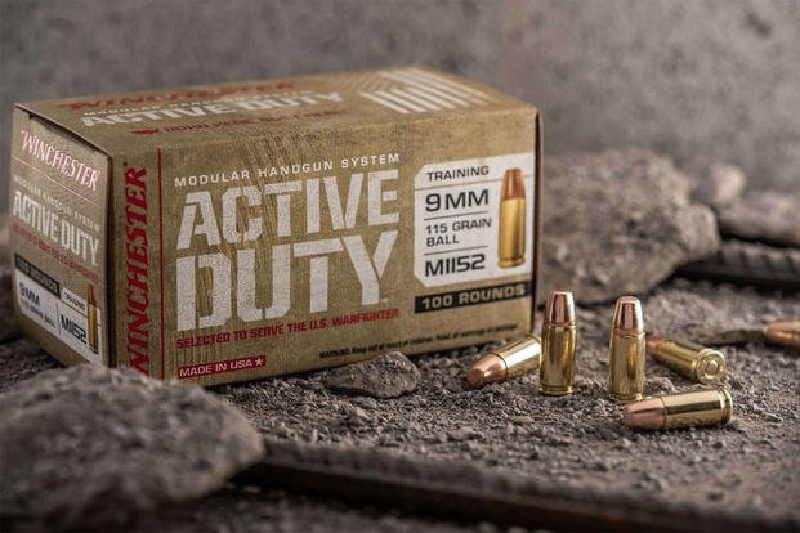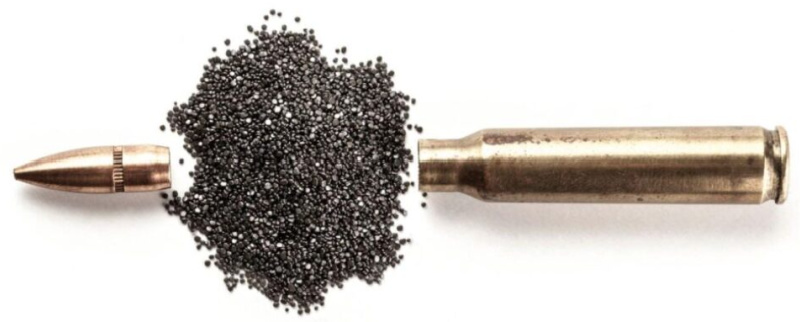Different components are used to make a single round of ammunition, and a round of ammo isn’t a bullet. How familiar are you with not only the various parts of a round of ammunition but the terminology related to it?

Components of Ammunition
From base to nose, the components of a round of ammunition can be easily summarized as the case, primer, powder, and bullet. You’ll also hear the case referred to as a cartridge. For the round to be fired, a firing pin or striker must impact the primer, which ignites the powder and sends the bullet down the barrel of the gun. Or, if it’s a rimfire round, it’s the edge of the base of the cartridge that’s impacted, not the center.
Everything varies by specific cartridge including primer size, quantity of gunpowder, and bullet type and weight. And, of course, the case itself changes depending on which cartridge it is. So while the basic parts of a single round of ammunition are simple, there are a lot of details to pay attention to whether you’re buying from a factory or handloading.

When it comes to firearms, knowing your terminology can be quite valuable. To help you out, here’s a list of ammunition terms to familiarize yourself with. Consider this your primer to all things ammo.
Common Ammunition Terms
ACP: Acronym that stands for Automatic Colt Pistol. For example, 45 ACP and 380 ACP.
Ammunition: This word is frequently shortened to ‘ammo’ which can refer to a single round of ammunition or an entire case full. Ammunition is what’s loaded into a gun for the purpose of firing bullets down range.
Ballistic Coefficient: A number calculated based on numerous factors including the diameter and weight of the bullet that relates to how those various features affect its ballistics (stability, air resistance, etc).
Ballistics: The practice or science of studying how projectiles travel including internal, external, and terminal ballistics.
Boat Tail: A bullet with a tapered base designed that way to enhance overall ballistics and create a more stable performance.
Bullet: The word “bullet” is frequently misused to refer to a complete round of ammunition. The bullet is actually the projectile portion of the round which is seated in the mouth of the brass or steel case. So while a bullet is a component of ammunition, it’s not the entire thing.
Caliber: This refers to the bullet diameter and also to the measurement of the bore of a gun which is taken by measuring the distance from one land to the land adjacent, although the latter is frequently also called bore diameter.
Cartridge: The term “cartridge” is used two ways in the gun world. One use refers to any complete round of ammunition, meaning it contains all necessary parts to function and has not yet been fired. The other use has to do with specific cartridge designations, such 9mm, 223 Remington, and 44 Magnum. Ever so often you hear “cartridge case” used to refer to the case of a cartridge. Some will argue about the precisely correct usage, but broadly speaking both uses are accurate.
Case: The case of a round of ammunition might be brass, steel, or some other metal (brass is the most common). The case is the component that contains the primer at its base, the powder inside it, and the bullet in its mouth. Case size and shape vary according to the cartridge. You’ll often hear case and cartridge used interchangeably to refer to the same part.
Centerfire: This is a type of ammunition that has the primer located in the center of the base of the case. Centerfire rounds are the most common and are used for handguns and long guns alike. Examples of centerfire ammunition include 380 ACP, 9mm, 50 BMG, and 357 Magnum.’

Crimp: The practice of folding, or crimping, the mouth of a case around the base of a bullet.
FPS: Acronym for feet per second which is a measurement of the velocity, or speed, produced by a specific bullet.
FT-LBS: Stands for foot-pounds, which is a measurement of the energy produced by a specific bullet.
Grain: A measurement used for propellants and bullet weight. For example, a 9mm bullet might be 115 grain or 140 grain, among other possibilities. There are 7000 grains in one pound.
Gun Powder: Frequently called propellant, gun powder is the dry, powdered chemical that’s put in the case of a round of ammunition. Gun powder, or propellant, does what its name suggests by igniting to create the gases and force necessary to push the bullet down the barrel of the gun. Today’s modern propellants are smokeless which is different than the old black powder used in centuries past.

LR: Acronym for Long Rifle, such as 22 LR.
Primer: For a centerfire round of ammunition to be fired, it needs a primer in place. The primer is a small, round disc that’s placed in the center of the base of the case. Primers are tiny cups that hold a small amount of explosive, usually lead styphnate or other chemicals such as antimony sulfide or barium nitrate. The size of the primer can vary depending on the cartridge. When the primer is struck by a firing pin or striker, it ignites and in turn, ignites the powder above it within the case.
Primer Pocket: A small, circular pocket in the base of a centerfire case where the primer is placed.
Propellant: See gunpowder.
Rimfire: A type of ammunition that uses a primer compound in the base of the case. Rimfires do not have a primer pocket to hold a primer like centerfires do. Firing a rimfire involves the rim of the base of the case being impacted rather than the center for the round to fire a bullet. An example of a rimfire is 22 LR.

SAAMI: Acronym for Sporting Arms and Ammunition Manufacturer’s Institute. SAAMI is the organization that creates and publishes industry standards for cartridges such as maximum pressure and overall length. A SAAMI-approved/accepted cartridge has a set standard unlike a wildcat, which might be loaded in different ways by various people.
Wildcat: A wildcat cartridge or round is one that’s handloaded rather than factory produced. Although the community of shooters might generally agree on wildcat loading specifications, there’s no set standard.


